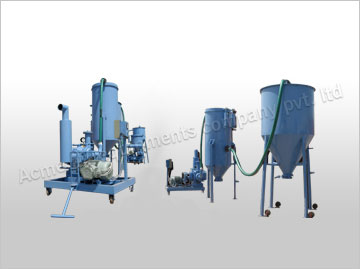Efficient material handling systems are crucial for industries worldwide. Among the many options available, Pneumatic Conveying Systems have gained significant place for their ability to transport bulk materials quickly, safely and efficiently. From food processing plants to chemical industries, these systems are revolutionizing material handling by replacing traditional methods.
In this article, we will delve into the global markets and industries where pneumatic conveyors are in high demand, highlight their numerous applications and explain why Acme Air Equipments stands out as a leading provider of innovative pneumatic conveying solutions?
What Are Pneumatic Conveying Systems?
A pneumatic conveying system is an automated material handling solution that uses airflow or vacuum to transport bulk materials through pipelines. These systems can handle powders, granules and other small-sized materials, making them versatile for a variety of industries.
Key Features of Pneumatic Conveyors:
- Flexibility: Can transport materials over long distances.
- Efficiency: Handles bulk materials quickly with minimal energy consumption.
- Dust-Free Operations: Ensures a cleaner and safer work environment.
- Customizable Design: Adaptable to meet specific industry requirements.
Global Markets for Pneumatic Conveyors
North America
- Demand Drivers: Safety regulations, automation trends and sustainability goals.
- Applications: Conveying sugar, flour and chemicals in high-volume manufacturing plants.
Europe
- Demand Drivers: Technological advancements and compliance with environmental standards.
- Applications: Transporting grains cement and metal powders across diverse industries.
Asia-Pacific
- Demand Drivers: Rapid industrialization and increasing investments in manufacturing infrastructure.
- Applications: Handling raw materials for electronics assembly and cement production.
Africa
- Demand Drivers: Growing focus on mechanization in mining and agriculture.
- Applications: Conveying minerals, fertilizers and biomass materials efficiently.
Middle East
- Demand Drivers: Expansion of oil refineries and petrochemical plants.
- Applications: Handling drilling powders, catalysts and cement.
Industries Where Pneumatic Conveyors Are Essential
Food and Beverage Industry
- Applications: Transporting flour, sugar, spices and other bulk materials.
- Benefits: Maintains hygiene standards, reduces contamination and ensures precise material handling.
Pharmaceuticals
- Applications: Moving active pharmaceutical ingredients, powders and granules.
- Benefits: Supports cleanroom operations and complies with strict regulatory standards.

Chemicals and Petrochemicals
- Applications: Transferring chemicals, catalysts and polymers.
- Benefits: Handles hazardous materials safely while minimizing spillage.
Mining and Cement
- Applications: Conveying minerals coal and cement.
- Benefits: Reduces material loss and ensures efficient bulk handling in tough environments.
Agriculture
- Applications: Moving grains, seeds and fertilizers.
- Benefits: Enhances productivity and prevents contamination during transport.
Plastics Industry
- Applications: Conveying plastic pallets, resins and powders.
- Benefits: Streamlines manufacturing processes with high efficiency.
How Pneumatic Conveyors Work?
Pneumatic conveyors operate by creating a pressure or vacuum to transport materials through pipelines. Here’s a breakdown:
- Material Entry: Bulk materials may introduce into the pipeline through feeders.
- Airflow Generation: A blower or vacuum pump creates airflow, moving materials through the pipeline.
- Transport: Materials are carried through pipelines to the desired destination.
- Separation: Materials are separated from the air at the discharge point using filters or cyclones.
Advantages of Pneumatic Conveyors
Flexibility in Material Handling
- Can handle a wide range of materials, from fine powders to granular substances.
Space-Saving Design
- Requires minimal floor space, making it ideal for industries with limited infrastructure.
Improved Safety
- Reduces dust emissions, minimizing health risks and fire hazards.
Low Maintenance Requirements
- With fewer moving parts, these systems require minimal maintenance compared to traditional conveyors.
Scalability
- Pneumatic conveyors can be customized to handle varying capacities, making them suitable for both small-scale and large-scale operations.
Why Choose Acme Air Equipments for Pneumatic Conveying Systems?
As a leading pneumatic conveying system manufacturer, Acme Air Equipments offers state-of-the-art solutions that meet global industry standards. Here’s what sets Acme apart:
Cutting-Edge Technology
- Acme integrates advanced engineering and automation to deliver efficient and reliable systems.
Customization Options
- From installation to maintenance, Acme provides end-to-end support to its clients.
Key Considerations for Choosing a Pneumatic Conveyor
Material Characteristics
- Evaluate the size, density and abrasiveness of the materials to be transported.
System Capacity
- Ensure the system can handle the required volume efficiently.
Pipeline Design
- Optimize pipeline layout to minimize pressure drops and energy consumption.
Environmental Factors
- Consider temperature, humidity and other environmental conditions that may impact performance.
Cost Efficiency
- Balance initial investment with long-term operational savings.
FAQs About Pneumatic Conveyors
Yes, pneumatic conveyors are designed to transport abrasive materials using wear-resistant components.
Acme’s pneumatic conveying systems are highly energy-efficient, reducing operational costs.
While they offer several advantages, pneumatic conveyors are best suited for specific applications like handling fine or hazardous materials.
No, with proper installation and periodic inspections, these systems require minimal maintenance.
Conclusion
The global demand for pneumatic conveying systems is on the rise, driven by industries seeking efficient, safe and flexible material handling solutions. From the food processing plants of North America to the mining operations in Africa, these systems are transforming how materials are transported.
With its advanced technology, customizable solutions and commitment to quality, Acme Air Equipments is at the forefront of this transformation. By investing in Acme’s pneumatic conveying systems, industries can optimize operations, reduce costs and stay ahead in today’s competitive market.
Read More Articles on Pneumatic Conveying System
- What is Pneumatic Conveying System?
- Advantages of Using a Pneumatic Conveying System: Enhancing Efficiency and Productivity
- Improving Product Quality through Contamination-Free Pneumatic Conveying Systems
- Pneumatic Conveying System Demand and Supply in the United States
- Pneumatic Conveying System Demand and Supply in Brazil





